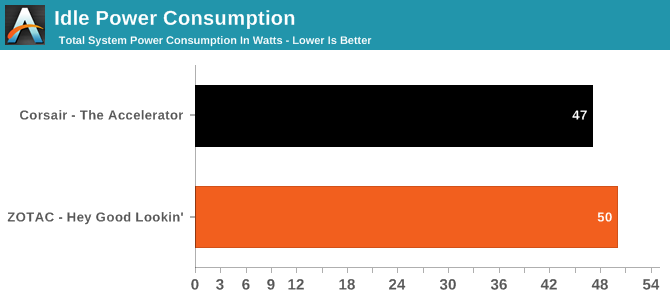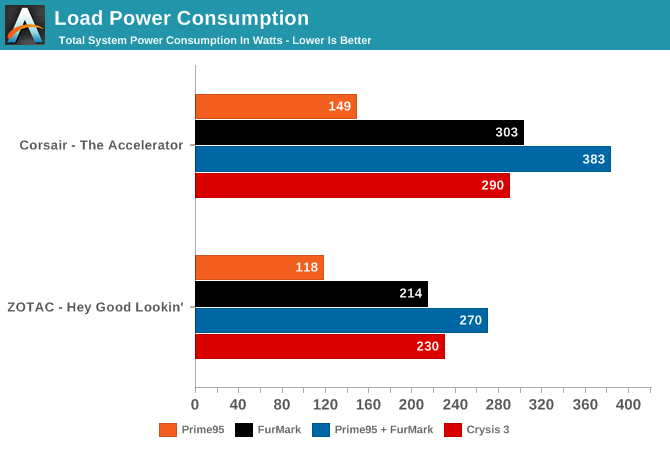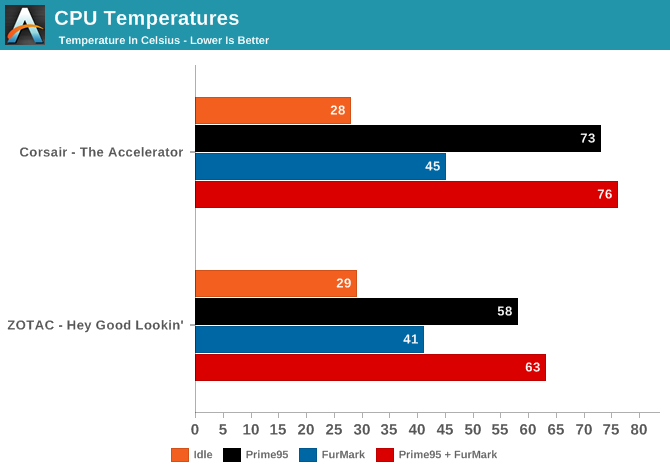Build-A-Rig Round 1, Zotac vs. Corsair: The $1500 PC Showdown
by Ryan Smith on August 5, 2015 6:00 AM EST- Posted in
- Build-A-Rig
- Systems
- Corsair
- ZOTAC
Power Consumption and Thermal Performance
Our final set of evaluation criteria for our Build-A-Rig systems is power consumptions and temperatures. Given the sometimes disparate component choices between Zotac and Corsair, we’re expecting to see some significant differences in power consumption here. Corsair went with more powerful components than Zotac, but their power consumption and overall thermal load should be higher than the Zotac system as a result.
Also throwing a wrench in things is of course the differences in cases. Both Zotac and Corsair went with low-to-mid range mid-towers, but due to differences in build layout, mounted coolers, and airflow, that will also have an impact.

With both systems based off of a Core i5 processor and GeForce GTX 900 series GPU, idle power consumption at the wall isn’t going to vary greatly. What difference we do see is mostly down to the PSUs; the Zotac system features a larger PSU, which all things considered is going to be a bit less efficient at idle than the Corsair PSU.

Load power consumption on the other hand isn’t too far off from what we’d expect. The most surprising result here may be Prime95, our CPU stress test, which finds that the Corsair system is drawing some 31W more at the wall. On paper both i5 CPUs should be close in power consumption, but in practice the lower clocked Core i5-4460 CPU in the Zotac system is going to draw less power than the top-tier Core i5-4690K in the Corsair system, leading to what we see here.
Otherwise once the GPU comes into play, the difference in power consumption between the two systems ramps up significantly. The GTX 980 Ti in the Corsair system has a TDP nearly 100W higher than the Zotac GTX 970, and under FurMark in particular it makes itself apparent. Even Crysis 3 sees a 60W difference at the wall, going hand in hand with the Corsair system’s better GPU performance.
So what does this do for temperatures? Both systems feature Corsair closed loop liquid coolers, with the Zotac system using the larger of the two, an H100i GTX. The bigger difference is that the Corsair system features a blower-type video card, whereas the video card in the Zotac system is open air, and as a result relies on the airflow from the CPU cooler to exhaust the bulk of the heat.


At idle CPU temperatures are similar, but under load we see the result of the Zotac build’s larger cooler and lower power processor. Granted for our CPU workload we’re running FurMark, about as close to a sadistic workload as one can get, but these also represent the hottest temperatures one should see. In any case the Zotac system’s CPU is some 13-16C cooler than the Corsair system’s, due to the difference in build configuration.
GPU temperatures are also in Zotac’s favor, again due to the lower power consumption combined with larger coolers, and in the case of the video card an open air design. The GPU is not significantly affected by the CPU, so what we see is the full impact of FurMark on each card. Ultimately the GTX 980 Ti reaches its default thermal limits, as we’d expect for a reference card, while the Zotac system and its Zotac GTX 970 remain much cooler thanks to its open air cooler. But in return the Zotac card is offloading some of the cooling workload to the chassis, so it’s a good thing the Zotac system features the larger H100i GTX 2x120mm CLLC.










21 Comments
View All Comments
Refuge - Monday, August 10, 2015 - link
It is down to perspective in the end.I like LED strips if done properly. I also thought the Zotac build was very pretty.
Mikemk - Wednesday, August 5, 2015 - link
So will the winners be announced publicly?Ryan Smith - Wednesday, August 5, 2015 - link
That's a good question. Our corporate parent technically executes the contest, so I'll check with them on the matter.Drumsticks - Wednesday, August 5, 2015 - link
These are cool! I hope you do them well into the future, it's exciting to see what the companies come up with and some friendly competition is always fun to watch.I'd love to see Dustin/future people who add unlocked CPUs to their builds have them tested with an overclock added by y'all - after all, it's a huge benefit and the CPU performance advantage for Corsair here is kind of understated without it.
Either way, no surprises with the results. Both builds did what people really expected; nobody saw Zotac winning many performance runs, but then again, they weren't really trying to with their picks.
Gasaraki88 - Thursday, August 6, 2015 - link
I don't get what the point of this article is. You take a computer that has a slower processor and video card and compare it to one that has a faster processor and video card. OK, guess who's slower?Ian Cutress - Thursday, August 6, 2015 - link
It's part of our give-a-way contest project called Build-A-Rig. We give two companies a budget and ask them to spec down a rig. We then interview them about the industry and what they chose, and then we get the parts from our partner Newegg, build the systems, test them, and then give them away to our readers.Read the intro: http://www.anandtech.com/show/9403/
Read the interviews and specification breakdowns: http://www.anandtech.com/show/9417/
Read the build logs for each system: http://www.anandtech.com/show/9474/
And this performance analysis is the final piece of the puzzle.
doggface - Sunday, August 9, 2015 - link
When I first saw that h100i in the zotac build it didnt make sense. Using it to blow away the heat from the 970 is clever.zerockslol - Saturday, August 15, 2015 - link
Anyone else notice the inconsistency with prices in the 90 day average?I added up the 90 day averages and it reached $1512.72 you're welcome
zerockslol - Saturday, August 15, 2015 - link
that was for Zotacs btwLegionosh - Monday, August 17, 2015 - link
While the Zoltac may look a little better, I'd much prefer the Corsair build due purely to performance reasons. The power consumption difference is nowhere near enough to warrant the performance difference in my opinion (and everyone has their own opinion).Granted the SSD does offer some performance benefits, but the difference in GPU and CPU performance more than makes up the difference for me. :-)